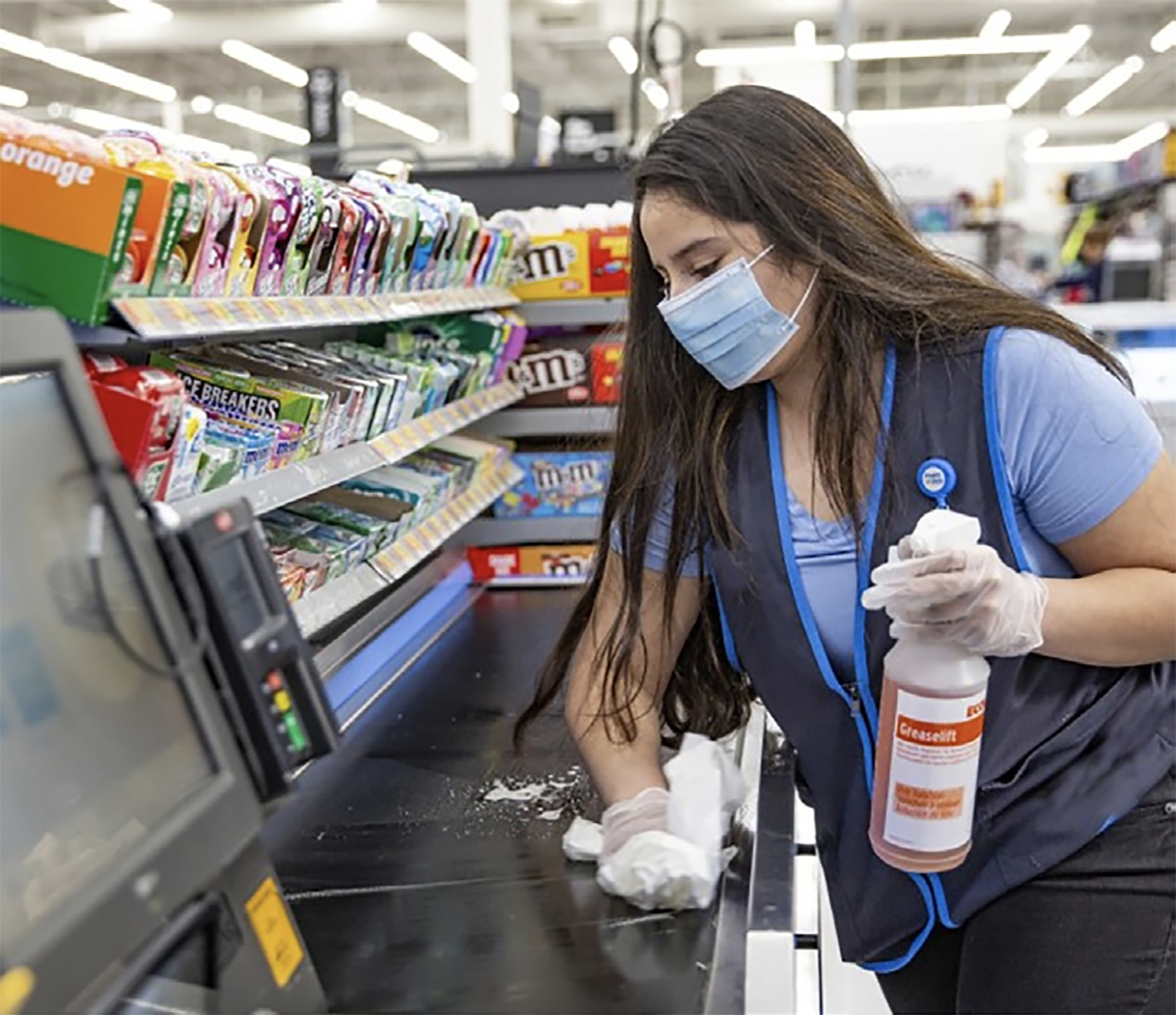
by Lina Stepick, Lola Loustaunau, Larissa Petrucci, and Ellen Scott
Despite the continuing threat of COVID-19, and after token efforts such as “hazard pay” to recognize the threat to frontline workers, life in grocery and other retail stores has returned to a new normal of work during a pandemic. Work continues to be dangerous for “essential workers.”
In April 2020, we interviewed workers on the front lines to find out what they were facing in those terrifying early weeks of the pandemic. This is the report we produced during the summer to alert the public to the drastic conditions of work for “essential workers.”
We found that those in retail and food services, who often do not choose this work, made then and continue to make impossible choices between putting their and their family members’ lives at risk or being unable to pay their bills. Hashtags #AlwaysAHero and #ForeverEssential underscored how the sacrifices workers are making have not abated and that low-wage work has always been essential. When asked what she would want policymakers to know about being a retail worker in the time of COVID-19, a retail worker replied, “Some of us don’t really have a choice. And the idea that we’re still showing up and putting ourselves essentially in harm’s way…It’s a lot more than the job that we signed up for.”
When the COVID-19 crisis hit Oregon, our Fair Scheduling Law Study research team reached out to our statewide sample of rural and urban, union and nonunion retail, food services, and hospitality workers we had previously interviewed and conducted over 50 interviews with workers in the last two weeks of April 2020 to ask: What does it mean to be an essential low-wage worker in this context?
No Choice but to Be Essential
Most of these workers have no safety net. They have little choice about whether to work. A Latina food services worker with asthma told us that her eleven-year-old daughter asks her to stay home, saying, “Mami, why do you have to go to work now?” Hers is the only income in her household so she has to continue working.
Very few reported having sufficient paid sick time. Even those who tested positive for COVID-19 felt pressured to return to work as soon as they were cleared by a doctor, even if they had not fully recovered, because they had used up their paid sick time.
A grocery worker said: “We were told we were allowed to go home if we didn’t feel safe. We were told that we have a choice. Do we have a choice, though, if that means that if we stay home for fear of our health? We won’t be able to pay our rent, and we won’t be able to purchase food. If we live paycheck to paycheck, like many of us do, we don’t really have a choice.”
More Hours, More Risk, More Instability
Workers in retail, food services, and hospitality typically experience highly unstable schedules and lack of guaranteed hours. Suddenly recognized as essential workers in the context of COVID-19, some got more hours and stable schedules. However, workers still face precarity: Additional hours were not permanent; work requirements shifted and intensified; work locations changed with the closing of some stores; and workers’ physical and emotional health was compromised. Workers found themselves in new stores, new departments, with new shifts, and new requirements to clean and stock. Others were laid off when businesses closed and workers did not know when they would return to work.
Customers Endanger Workers’ Physical and Emotional Health
For workers who were left at stores, they had to contend with customers flooding stores, panic-buying toilet paper and other goods. Workers reported that customers were anxious and angry; interactions became emotionally charged. Workers felt persistent anxiety about customer harassment and potential infection. They described the emotional labor they performed to reassure anxious and lonely customers, while also experiencing increased stress, anxiety, and new levels of emotional exhaustion at the end of the day.
Workers found themselves having to combine “good customer service” with management of uncooperative customers. A Latina food services worker noted, “We are all cooped up like parakeets because it has been so much time. And that upsets people, so customers shout at you and that can make you scared.” Workers of color were particularly vulnerable, having experienced increased racial harassment from customers in the context of heightened xenophobia during COVID-19. Another Latina food services worker said that customers, “ask me things like, ‘Why are you here? You almost don’t speak the language.’ It seems to me like there is more racism now.”
Variable Levels of Workplace Safety
Lack of clear governmental guidelines to protect essential workers, especially during the initial weeks of the pandemic, created a situation where workers have been subject to highly variable responses by employers and varying degrees of exposure to health risks. More protective measures included requiring workers to wear masks, installing protective shields at checkstands, and establishing additional cleaning and social-distancing procedures. Workers had their temperatures taken upon arriving at work, and they were offered the option of 6 weeks paid leave. In less proactive businesses, workers waited weeks to receive PPE, social distancing was not enforced, and COVID-19-specific paid sick leave was only available for workers who tested positive for the virus, and not for others with underlying health conditions.
Worker Recommendations
When asked what recommendations they would have for policymakers, workers stressed the need for structural change. Many discussed the need for universal health care, arguing that employer-provided coverage is expensive and inadequate. Some suggested extending and expanding direct payments to workers (including migrant workers), unemployment benefits, and the need for a universal basic income. Many highlighted the importance of expanded paid sick leave so that workers could make the decision to stay home.
Within the workplace, employees recommended expanded and extended hazard pay, PPE provided for them, and enforced standardized procedures for social distancing. For temporarily unemployed workers, the right to return and worker-retention policies with earned seniority could mitigate workers’ anxieties by ensuring they will have jobs to return to when business resumes.
Several workers argued that if they are essential workers pressured to work through a pandemic, then government officials and companies should mandate that consumers come into stores only for essential goods, and limit shopping trips. They argued it was unfair for workers to endanger their own lives so that customers could have an outing and buy nonessential items. Workers also suggested that there ought to be clear governmental guidelines to limit the number of customers in stores.
Some workers discussed protections for the right to organize. Workers at unionized stores shared that having the protection of a union helps them feel they can speak up about safety issues without fearing retaliation. In contrast, some nonunion retail workers have been subjected to captive-audience, anti-union meetings and some have been fired for organizing for safety measures.
Overall, employers have placed the burden on workers as individuals to keep themselves and the public safe, but workers stressed that structural changes and collective action are particularly necessary in this moment.
—Sociology professor Ellen Scott received 2020 grant funding from CSWS’s Mazie Giustina Fund for Women in the Northwest for a comprehensive study of the effects of Oregon’s Fair Scheduling Legislation.
Read More
Alvarez, Camila. H., Loustaunau, Lola, Petrucci, Larissa, and Scott, Ellen. 2019. “Impossible Choices: How Workers Manage Unpredictable Scheduling Practices.” Labor Studies Journal, 45 (2): 186–213.
Loustaunau, Lola, Larissa Petrucci, Ellen Scott, and Lina Stepick. 2020. “Assessing the Initial Impacts of the First Statewide Predictive Scheduling Law.” Policy Research Brief prepared for Center for Popular Democracy, University of Oregon.
Lola Loustaunau, Lina Stepick, Ellen Scott, Larissa Petrucci, and Miriam Henifin. Forthcoming. “No Choice but to Be Essential: Expanding Dimensions of Precarity During COVID-19.” Sociological Perspectives.

